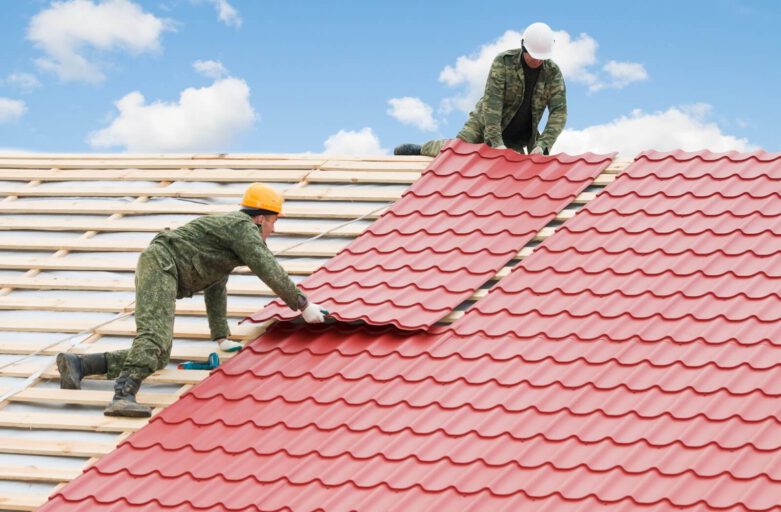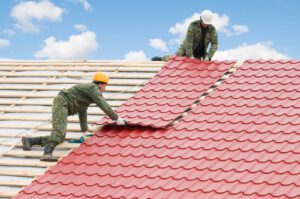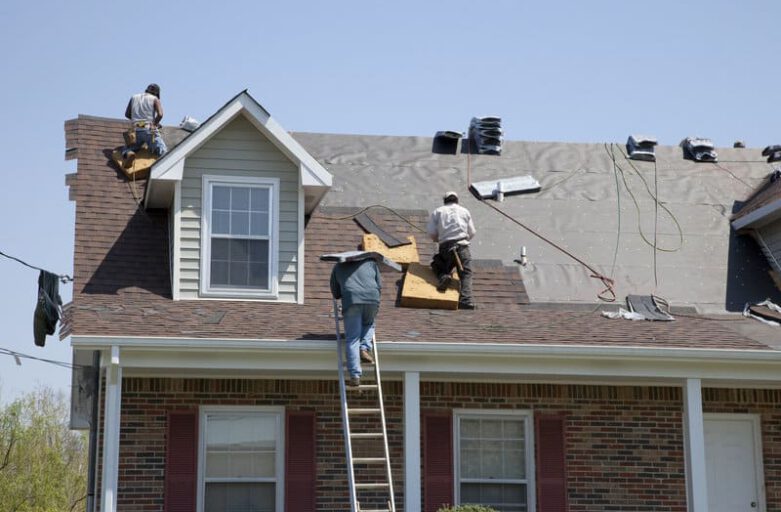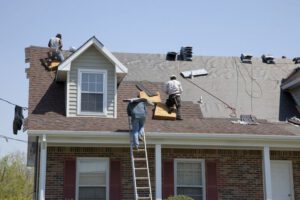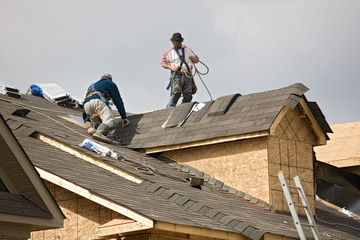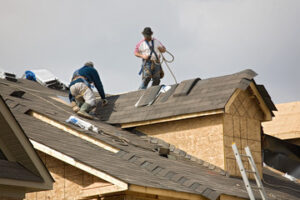A roof protects a building against rain, snow, sunlight, and temperature extremes. Roofing West Chester PA builds roofs in a tremendous variety of forms.
Wood shingles are typically made from oak and chestnut, which offer natural durability. However, wood can rot or harbor termites and other insects. It also requires more maintenance than other roofing materials.

Shingles, made of asphalt, wood, clay, or slate, are one of the most recognizable elements of any roof. They protect a home through a layering system that prevents water penetration, keeping your living space dry and comfortable. But shingles do more than just keep your house’s interior dry; they also add visual interest to its exterior. They come in many shapes, sizes and colors, making them a versatile choice for any aesthetic.
The most common roofing shingle is the 3-tab variety, which has a single layer with cut-outs forming 3 individual tabs. They are relatively inexpensive and commonly used for new construction. Premium/designer shingles have a more varied aesthetic, offering shape options like slate or tile as well as color options that complement other features of your home’s exterior. These shingles can also have improved performance characteristics, such as impact resistance.
Other types of shingles include wood shakes, which are a time-honored roofing material dating back centuries or more. They’re not as expensive as other roofs, and they have a natural look that can make your house stand out among others in your neighborhood. However, they require regular maintenance to keep them in good condition.
Some shingle types offer energy-efficiency benefits, helping to reduce your power bills by reflecting the sun’s infrared radiation and keeping your attic cooler. This is especially important for homes in warmer climates, where proper ventilation and meeting Department of Energy guidelines for attic insulation are crucial.
Another important characteristic of a shingle is its durability. The material must be strong enough to resist weathering and aging, while remaining lightweight for ease of installation. It also must be able to withstand the weight of snow or ice. Most shingles are designed to last for decades, but they do eventually need replacing, either because of damage or as the result of age-related wear and tear.
The first step in installing a shingle roof is to cover the entire area with a waterproof underlayment. It’s then necessary to flash all areas where the shingles butt up against other structures, such as vents, chimneys, pipes and plumbing stacks. Depending on the roof, the flashing may be hand-rived or milled slate. If a closed valley is chosen, the end of each shingle course should be nailed at least 2” back from the valley centerline, so that no water can seep under the shingles and cause leaks.
When people think of their roofs, they usually focus on the shingles that protect the house from rain and other weather elements. What they often forget is the underlayment, which helps prevent shingle damage and extends the lifespan of the roof. This is why underlayment should always be properly installed on new construction or reroofing projects.
Depending on the type of roofing being installed, there are three common types of underlayment: felt, self-adhered, and synthetic. The type of underlayment that is used will depend on the roofing contractor’s experience, local building codes and regulations, and the roofing style that the homeowner wants to install.
One of the most traditional types of underlayment is asphalt-saturated felt, also known as “felt paper” or “tar paper.” This material is typically made from varying blends of organic mat or paper that have been saturated with asphalt to help with water resistance and strength. It is available in 15- or 30-pound variants and is typically fastened with staples on a roof structure. Felt underlayment is a good choice for lightweight projects, but it can tear easily. It is also not waterproof, so it must be protected from moisture through the use of a water-resistant roof covering.
In contrast, rubberized asphalt underlayment is a more modern option that offers enhanced waterproofing and other benefits. It is commonly installed on new roofs or reroofing projects in the area around leak-prone areas, like chimneys, vents, skylights, and eaves. It is a strong, lightweight, and slip-resistant underlayment that is easy for workers to install.
Another benefit of rubberized asphalt underlayment is that it is a vapor barrier and helps to prevent trapped moisture from damaging the roof deck and interior of the home. This can lead to mold, mildew, or rot, which are not only unsightly but can also be hazardous to health. This is why it’s important to have a professional install a premium roof system that includes this advanced underlayment material.
Flashing is thin pieces of impervious material that are installed to prevent the passage of water into a structure from a joint. It’s commonly used around chimneys, vent pipes, walls, windows and doors. It helps to make buildings more durable, reduce indoor mold problems and protect against other types of water damage like rot and rust. Flashing is made from a variety of materials, including copper, aluminum, galvanized steel and zinc alloys. It’s generally replaced with every new roof, but it needs very little maintenance in between replacements. Light cleaning and basic inspection are all that’s needed to keep it working properly.
There are many different types of flashing, and they’re categorized by how they’re installed or by the surface they cover. Most are made from metal, but they can also be made of plastic, lead or other non-metal materials. They’re most often installed where roof penetrations or gaps are prone to leaks, such as the areas where two downward slopes meet, the valleys of the roof and the areas around roof features like chimneys, dormers and vent pipes.
Roof flashing is a type of weatherproof material that professional roofers use to seal these vulnerable seams. It’s usually a type of galvanized steel, and it’s bent into the shape of a joint to protect the area from rain, wind and snow. It’s installed over the waterproof underlayment and shingles, but it’s not attached to the shingles.
Roofing professionals install several kinds of flashing to address different situations. For instance, they use step flashing to line the joints of a roof where shingles are layered at an angle. This is important because the angled shingle layers create a sloping surface that can collect rainwater and leak through the seam. Step flashing is a series of rectangles of sheet metal that overlap like fish scales to form a protective ridge.
Other flashing types are designed to seal piping and other utility penetrations through exterior walls. They’re typically made of metal, and they may have built-in expansion joints to allow the material to flex as the home expands and contracts with changes in temperature. One popular type of pipe flashing is a collar that fits over a pipe’s opening and has an expansion flap that allows it to expand and contract with the pipe.
While metal roofs have long been a common sight on commercial buildings, they’re increasingly popular with homeowners thanks to their durability and longevity. The types of metal used in roofing vary, and you can find options that match just about any architectural style.
The most common type of metal for roofing is galvanized steel, but you can also choose from aluminum or galvalume (a combination of zinc and aluminum). These are all durable materials that hold up well to corrosion, which is particularly important if you live in a coastal area where salt air is prevalent.
One benefit of metal is its strength, but you should keep in mind that it’s not as pliable as asphalt shingles when it comes to hail damage. In fact, metal is much more likely to dent than other roofing types unless you’re careful to install the right underlayment. Steel is stronger than aluminum and tends to fare better in hailstorms, but pea-sized or even dime-sized hail can still ruin a metal roof.
Another consideration is the gauge of the metal you select. Gauge refers to the thickness of the metal, and different thicknesses offer varying degrees of protection. For example, a 29-gauge roof offers 40% more dent resistance than a 24-gauge roof.
When you’re looking at metal roofing, it’s also important to consider the manufacturing process and the panel types available. For example, many residential metal roofs are made of corrugated panels, which have a seam that overlaps and is fastened with exposed fasteners. While there are treatments that can help protect these fasteners, you’ll need to have them inspected on a regular basis.
The most common method for producing a metal roof involves feeding a coil of metal into a roll-former. This machine flattens and shapes the coil into various standing seam profiles, as well as cutting it into specific length panels. It’s important to note that the paint on the metal stays intact during this process, which helps prevent the roof from corroding. The metal is then coated with several layers of anti-corrosion paint.

